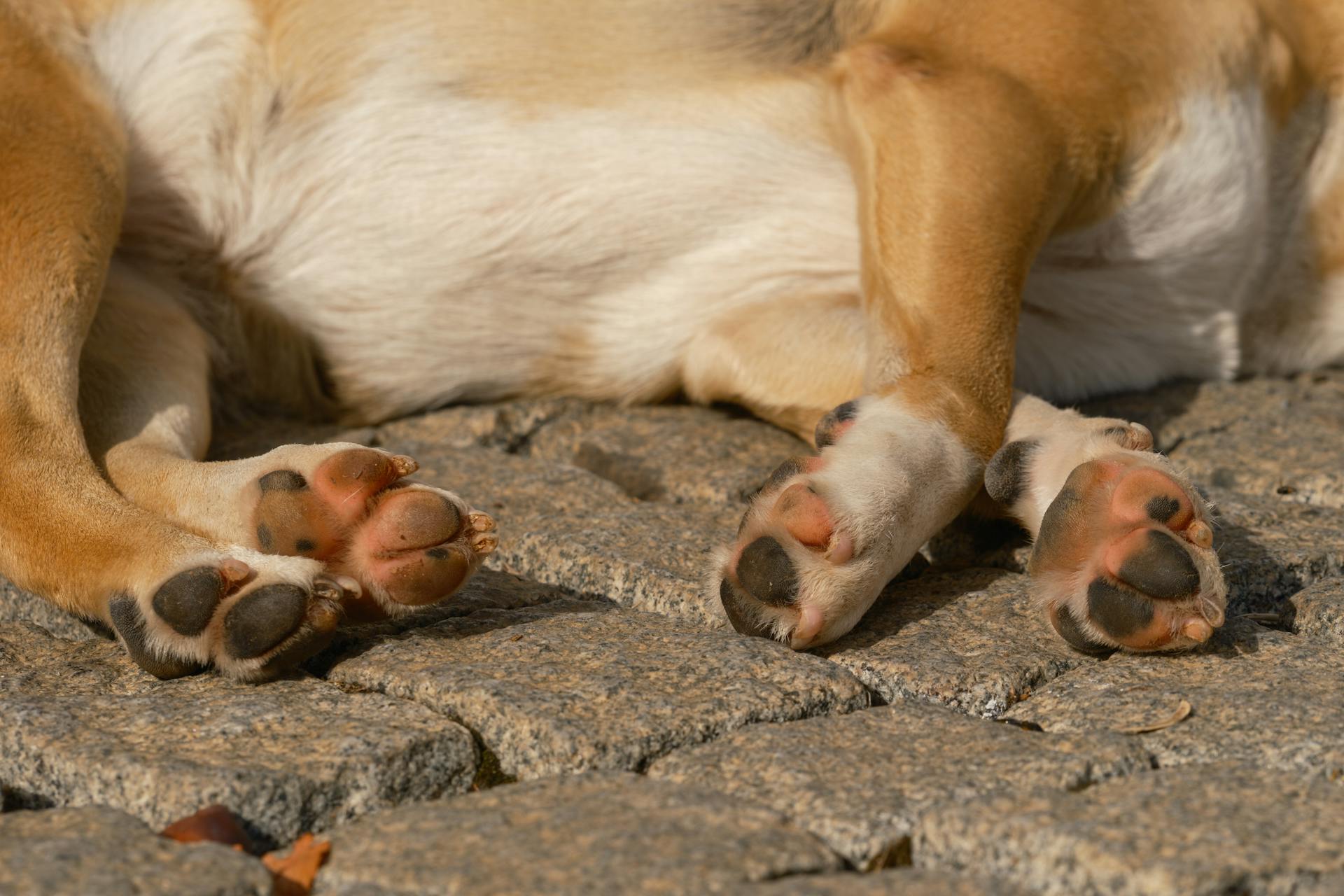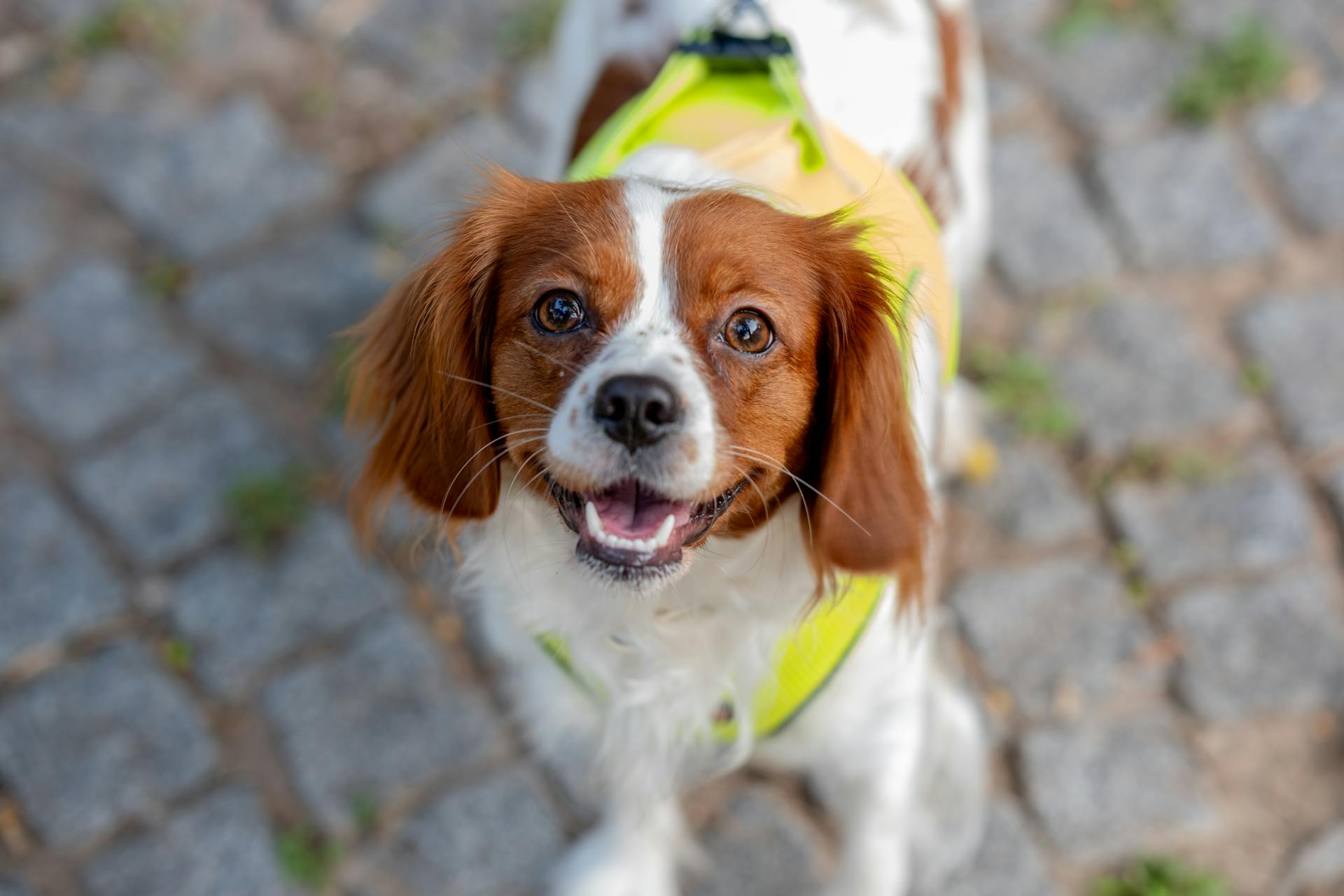
The canine forelimb is a remarkable structure that enables dogs to move, run, and even jump with incredible agility. It's composed of the scapula, humerus, radius, and ulna bones, which work together to provide a wide range of motion.
The scapula, or shoulder blade, is a flat, triangular bone that serves as the foundation for the forelimb. It's attached to the ribcage and provides a stable base for the arm to move.
The humerus, or upper arm bone, is the longest bone in the forelimb and connects the scapula to the elbow joint. It's a sturdy bone that allows for flexion, extension, and rotation of the arm.
The radius and ulna bones, also known as the forearm bones, are located below the elbow joint and play a crucial role in forearm movement.
Discover more: Canine Scapula Anatomy
Canine Forelimb Anatomy
The canine forelimb is made up of several key components, each with its own unique anatomy and physiology. The extrinsic musculature of the canine forelimb is crucial for movement and function.
The muscles of the canine shoulder play a vital role in controlling the movement of the forelimb. You can find more information on these muscles through the OVAM Anatomy Museum Resources.
The antebrachium, or forearm, is a critical part of the canine forelimb. The muscles of the canine antebrachium work together to facilitate movement and flexibility.
Here's a breakdown of the main muscles of the canine forelimb:
Understanding the anatomy and physiology of the canine forelimb is essential for veterinarians and animal lovers alike.
Joint Structure
The joint structure of a canine's forelimb is quite fascinating. The shoulder joint, in particular, is unique in that its joint capsule barely extends past the areas of articulation, except where it continues distally into the intertubercular groove of the humerus.
This groove provides cushioning and synovial support for the bicipital tendon, which is held in place by the transverse humeral retinaculum. The bicipital tendon and the joint capsule pouch are carefully positioned between the greater and lesser tubercles of the humerus.
The radius and ulna bones in the canine's forelimb are connected by the interosseous ligament, which joins them mid-shaft. The remainder of the space between these bones is filled by the interosseous membrane.
Proximal Limb Joints
The shoulder joint is a fascinating structure that deserves some attention. The joint capsule barely extends past the areas of articulation, except where it continues distally into the intertubercular groove of the humerus.
This unique design provides cushioning and synovial support for the bicipital tendon. The bicipital tendon and the joint capsule pouch are held in place by the transverse humeral retinaculum, which lies between the greater and lesser tubercles of the humerus.
In contrast, the radius and ulna are joined mid-shaft by the interosseous ligament, the remainder is filled by the interosseous membrane. This is a crucial aspect of the forearm's structure, allowing for flexibility and movement.
Here's a quick rundown of the key components involved:
The proximal limb joints, including the shoulder joint, are designed for optimal movement and support. By understanding these intricate structures, we can appreciate the complexity and beauty of the human body.
Distal Limb Joints
The distal limb joints are a complex system that requires a good understanding of its components. The muscles of the carpal and digital joints play a crucial role in facilitating movement.
Extensor muscles, such as the Extensor carpi radialis, Ulnaris lateralis, and Extensor carpi obliquus, are located at the craniolateral position on the forearm. They all originate from the lateral epicondyle of the humerus and are innervated by the radial nerve from the brachial plexus.
The common Digital Extensor and Lateral Digital Extensor are also extensor muscles located at the caudal position on the forearm. They originate from the caudal medial epicondyle of the humerus and are innervated by the median or ulnar nerve of the brachial plexus.
Flexor muscles, such as the Flexor carpi radialis and Flexor carpi ulnaris, are located at the caudal position on the forearm. They originate from the caudal medial epicondyle of the humerus and are innervated by the median or ulnar nerve of the brachial plexus.
The Superficial Digital Flexor and Deep Digital Flexor are also flexor muscles located at the caudal position on the forearm. They originate from the caudal medial epicondyle of the humerus and are innervated by the median or ulnar nerve of the brachial plexus.
Musculature and Vasculature
The canine forelimb anatomy is a vital part of understanding our furry friends' overall health and movement. Understanding the musculature and vasculature of the forelimb is crucial for any dog owner or enthusiast.
The vasculature of the forelimb is comprised of arteries, veins, and lymphatics, which work together to supply oxygen and nutrients to the muscles and tissues.
Here's a breakdown of the main components:
- Arteries of the Forelimb: responsible for carrying oxygenated blood to the muscles and tissues
- Veins of the Forelimb: carry deoxygenated blood back to the heart
- Lymphatics of the Forelimb: help to remove waste and toxins from the muscles and tissues
By understanding the intricacies of the canine forelimb's musculature and vasculature, we can better appreciate the amazing complexity of our canine companions' anatomy.
Proximal Structures
The proximal forelimb and shoulder are made up of several key structures. These include the pectoral muscles, which are innervated by the brachial plexus.
The brachial plexus is a complex network of nerves that arises from spinal nerves C6 to T2. It's a vital part of the musculature and vasculature of the forelimb.
The serratus ventralis muscle is another important structure in the proximal forelimb. It's innervated by a branch of the brachial plexus.
Here's a breakdown of the nerves that affect the forelimb, grouped by their origin and function:
Extrinsic Musculature
The extrinsic musculature plays a crucial role in joining the forelimb to the trunk, forming a synsarcosis rather than a conventional joint.
These muscles work together to transfer the weight of the body to the forelimbs as well as stabilize the scapula.
The trapezius muscle is one of the key players in this group, helping to transfer weight and stabilize the scapula.
The brachiocephalic muscle is also part of this group, although its specific role is not further described in the text.
The latissimus dorsi muscle is another muscle that forms part of the extrinsic musculature.
The serratis ventralis muscle is also mentioned in the text, but its specific role is not further described.
The rhomboids are another muscle that forms part of the extrinsic musculature.
The deltoids are also part of this group, although their specific role is not further described in the text.
You might like: Canine Muscle Anatomy
Limb Vasculature
Limb vasculature is a complex network of blood vessels that supply oxygen and nutrients to the muscles. This network is essential for proper muscle function and overall health.
The arteries of the forelimb play a crucial role in supplying oxygenated blood to the muscles. They branch off from the aorta and travel down the arm, eventually dividing into smaller vessels that supply the muscles.
Veins of the forelimb are responsible for returning deoxygenated blood back to the heart. They collect blood from the muscles and merge into larger vessels that ultimately return to the heart.
The lymphatics of the forelimb help to remove waste and excess fluids from the muscles. They work closely with the veins to ensure that the muscles are properly drained of waste products.
Here's a breakdown of the main blood vessels in the forelimb:
- Arteries: supply oxygenated blood to the muscles
- Veins: return deoxygenated blood back to the heart
- Lymphatics: remove waste and excess fluids from the muscles
Distal Limb Structures
The distal limb structures of a canine forelimb are quite fascinating. The distal limb includes the carpus, metacarpus, and phalanges, which work together to form the paw.
For another approach, see: Canine Thoracic Limb Anatomy
The carpus, also known as the wrist, is made up of seven carpal bones that articulate with the radius and ulna. These bones provide a wide range of motion for the paw.
The metacarpus, or metacarpal bones, connect the carpus to the phalanges. There are five metacarpal bones, one for each digit.
The phalanges are the bones that make up the individual toes. There are three phalanges in each digit, except for the hallux, or thumb, which only has two.
The distal limb structures are essential for a dog's mobility and dexterity, allowing them to grasp and manipulate objects with their paws.
Bones and Joints
The shoulder joint is a fascinating part of the canine forelimb anatomy. The joint capsule barely extends past the areas of articulation, except where it continues distally into the intertubercular groove of the humerus.
This provides a crucial cushioning and synovial support for the bicipital tendon. The bicipital tendon and the joint capsule pouch are held in place by the transverse humeral retinaculum, which lies between the greater and lesser tubercles of the humerus.
The radius and ulna are joined mid-shaft by the interosseous ligament, the remainder is filled by the interosseous membrane. This unique arrangement allows for flexibility and support in the forelimb.
Common Structures
The muscles of the forearm are quite fascinating, and understanding their structure can help you appreciate the intricate mechanics of the carpal and digital joints.
Extensor carpi radialis, ulnaris lateralis, and extensor carpi obliquus (also known as abductor pollicis longus) are all located at the craniolateral position on the forearm, originating from the lateral epicondyle of the humerus.
They are innervated by the radial nerve from the brachial plexus, which is a complex network of nerves that control various bodily functions.
The common digital extensor and lateral digital extensor are located at the caudal position on the forearm, originating from the caudal medial epicondyle of the humerus.
They are innervated by the median or ulnar nerve of the brachial plexus, which plays a crucial role in controlling the movement of the forearm and hand.
Flexor carpi radialis, flexor carpi ulnaris, superficial digital flexor, and deep digital flexor are all located at the caudal position on the forearm, originating from the caudal medial epicondyle of the humerus.
These muscles are essential for flexion and extension of the wrist and fingers, allowing us to perform a wide range of daily activities with ease.
Radius
The radius is a bone located in the forearm, and it's a crucial part for movement and stability. It starts on the lateral side and ends on the medial side.
A radial tuberosity provides a site of attachment for the brachialis and biceps brachii muscles. This roughened area can be quite variable in size in dogs and may even be non-existent in some cases.
The radius forms a joint with the humerus, specifically with the capitulum and trochlea. This joint allows for a wide range of motion in the elbow.
Here are some key facts about the radius:
- Site of attachment for brachialis and biceps brachii muscles
- Variable in size in dogs, may be non-existent
- Forms a joint with the capitulum and trochlea of the humerus
Sources
- https://en.wikivet.net/Canine_Forelimb_-_Anatomy_%26_Physiology
- https://en.wikivet.net/Forelimb_-_Anatomy_%26_Physiology
- https://studentvet.wordpress.com/2010/07/27/canine-forelimb-anatomy/
- https://pubmed.ncbi.nlm.nih.gov/15562505/
- https://www.cliniciansbrief.com/article/orthopedic-examination-forelimb-dog
Featured Images: pexels.com


